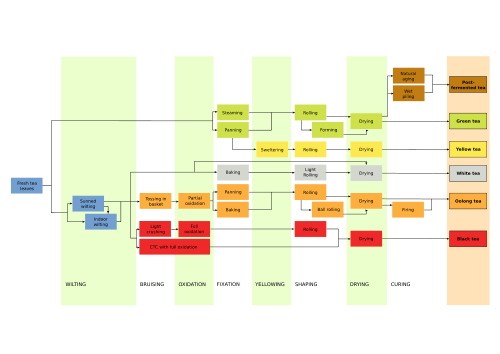
Redox
Redox is a contraction of the name for chemical reduction-oxidation reaction. A reduction reaction always occurs with an oxidation reaction. Redox reactions include all chemical reactions in which atoms have their oxidation state changed; in general, redox reactions involve the transfer of electrons between chemical species. The chemical species from which the electron is stripped is said to have been oxidized, while the chemical species to which the electron is added is said to have been reduced. Oxygen is not necessarily included in such reactions as other chemical species can serve the same function.
The term "redox" comes from two concepts involved with electron transfer: reduction and oxidation. It can be explained in simple terms:
Although oxidation reactions are commonly associated with the formation of oxides from oxygen molecules, these are only specific examples of a more general concept of reactions involving electron transfer.

Tea processing
Tea processing is the method in which the leaves from the tea plant Camellia sinensis are transformed into the dried leaves for brewing tea.
The categories of tea are distinguished by the processing they undergo. In its most general form, tea processing involves different manners and degree of oxidation of the leaves, stopping the oxidation, forming the tea and drying it.
The innate flavour of the dried tea leaves is determined by the type of cultivar of the tea bush, the quality of the plucked tea leaves, and the manner and quality of the production processing they undergo. After processing, a tea may be blended with other teas or mixed with flavourants to alter the flavour of the final tea.
History
The history of the tea processing corresponds intimately with the role that tea played in Chinese society and the preferred methods of its consumption in Ancient Chinese society.
Green
The ancient Chinese society first encountered the tea plant in what is now southern China and processed it as another medicinal herb for use in Chinese herbology. The processing technique used to process fresh tea leaves was to immediately steam the fresh tea leaves and dry them for preservation, which is likely the most ancient Chinese form of tea leaf processing. This processing method was perfected near the end of the Han Dynasty (206 BCE-220 CE) and produced a dried tea that would be classified today as "green tea" and quite similar to modern Japanese sencha. For consumption, dried tea leaves were either decocted with water around with other herbs, or ground into a powder to be taken straight or in a liquid.

Alpha oxidation
Pathway
Alpha-oxidation of phytanic acid is believed to take place entirely within peroxisomes.
(Propionyl-CoA is released as a result of beta oxidation when the beta carbon is substituted)
Deficiency
Enzymatic deficiency in alpha-oxidation (most frequently in phytanoyl-CoA dioxygenase) leads to Refsum's disease, in which the accumulation of phytanic acid and its derivatives leads to neurological damage. Other disorders of peroxisome biogenesis also prevent alpha-oxidation from occurring.
References
Podcasts:

